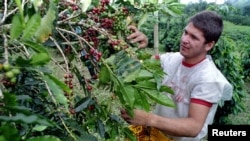The 2014 farming season has unfurled against a backdrop of swelling despair for Cameroon’s coffee sector. Harvests of the nation’s once-blooming cash crop have hit an all-time low with of more than 50 percent slump from the previous year.
Growers, dealers, experts and farmer organizations are all piling blame on faulty government policies dating back to the early 1990s and calling for renewed subventions to farmers.
The Interprofessional Cocoa and Coffee Council says yields from the 2012-2013 season stood at just over 16,000 tons, down from above 38,000 previously. Meanwhile between the 70s and 90s, Cameroonian coffee growers were among the country’s wealthiest farmers.
“Our coffee is currently in very bad shape,” says Omer Gatien Maledy, executive secretary of the council. “That’s the lowest figure we’ve known since Cameroon started growing coffee in 1957. And yet, we’ve known prosperous years. In 1990, we exported 156,000 tons. That was our best year.”
Back then, the vastly fertile country was ranked 12fth among the world’s biggest coffee growers. Today, it falteringly sits on the 31st position and experts fear the yields slumps could continue even further over the coming years.
Bad roads and a changing climate
Ngewou Thomas is a farmer and exporter in Nkongsamba, a colonial town in the Littoral region once known as the “Coffee Capital of Cameroon.” He says the poor yields last year could not be averted.
“A lot of coffee was abandoned in the farms because access roads were not maintained,” says Thomas. “Elsewhere, soils are sufficiently old and the big farmers in the years gone by are all ageing out or dead and their children are leasing out the farms to banana producers and heading off to the cities.”
Experts offer several other factors that contributed to the failures: longer rainy seasons provoked by climate change causing massive falling of leaves before pollination; costly inputs like fertilizers and pesticides; lack of mechanization; the absence of large-scale farming as well as alleged sidelining of coffee in the allocation of government technical support and grants.
The ongoing coffee production dips began with the global economic crisis of the mid-80s that provoked sharp price plunges on the world market. Across the major growing hubs in the western, coastal and southeastern parts of Cameroon, demoralized farmers even uprooted coffee plants in preference for quick-maturing crops like beans and corn which are more readily marketable locally.
Officials say rather than step up incentives to empower coffee growers weather the economic go-slow, the government blundered by freezing subventions, liberalizing the sector and fueling the downfall of cooperatives.
Blame falls on government policies
“If we are honest, then we should acknowledge the fact that government policies beginning in the 90s led to the situation we find ourselves in today,” said Thomas.
Former trade and industry minister Patrice Mandeng Ambassa says, “Unfortunately, I was the last minister to have fixed prices for cocoa and coffee back then.” He is now president of the Finance Commission at the National Assembly.
“After that total liberalization of the sector followed with the consequences being that the maintenance of basic infrastructure like roads stopped, the state stopped providing subventions. So, farmers suddenly found themselves with financial burdens they had not planned for.”
The Interprofessional Cocoa and Coffee Council believes the problems blighting the sector have been sufficiently diagnosed, but there is a need for fresh political will at the level of the government to re-launch coffee production.
The government appears to be responding positively. They are talking with Brazilian experts who could teach Cameroonian farmers their best practices. The International Coffee Organization may offer training programs and transfer technology.
In the meantime, the Council has announced it is disbursing 750 million FCFA - about $1.5 million dollars - in an emergency relief plan to halt the plummeting harvests over the coming five years with assorted assistance and support programs.
Optimism is on the horizon
“World demand for coffee is constantly on the rise,” says Maledy, “and projections show that up to 2020 and 2025, demand will grow by 2.2 percent and so coffee must be produced.
“Countries like Brazil - the world’s leading producer - can no longer chop down the Amazon to expand plantations due to calls for environmental preservation.
“And the second-leading producers - Vietnam and Indonesia - are actually reducing their coffee-growing areas. So, we have a huge opportunity in Cameroon and it will be unfortunate if we don’t benefit from the situation.”
Elsewhere, farmers are saluting a decision by the European Union to grant the country a non-reimbursable US$30 million for the revival of robusta coffee production. They propose to resurrect abandoned plantations, restore cooperatives, and improve product quality and commercialization channels.






